23 May 2019
Rare and threatened trees at Wakehurst
Meet four precious trees that are conserved at Wakehurst.

Franklin tree (Franklinia alatamaha)
IUCN conservation status: Extinct in the wild
This stunning tree has elongated, dark green leaves and large white flowers with clusters of golden-yellow stamens.
The Franklin tree is known for its white flowers which smell of honeysuckle, and can grow up to 10m tall.
It was first recorded by botanists along the Altamaha River in Georgia, USA.
The last report of the tree in the wild was in 1803. Although many attempts have been made to re-establish the tree back in the wild, they've been unsuccessful and it's now classified by the IUCN as extinct.
To make sure this special tree is protected in the future, we've harvested and stored the seed in the Millennium Seed Bank.
Come and see it for yourself at Wakehurst. We have two flourishing in the gardens - one is on the right-hand side of the path leading to the Black Pond, and the second is in Horsebridge wood.
.jpg.webp?itok=imtWRVS7)
Spanish fir (Abies pinsapo)
IUCN conservation status: Endangered
The Spanish fir an evergreen tree, native to southern Spain and northern Morocco.
There have been lots of conservation efforts to restore the abundance of this tree, but it's still considered a threatened species.
Wakehurst is home to a large specimen of Abies pinsapo var. marocana, which grows in Morocco. You can find it growing on the left side of the path towards the Pinetum.
The seeds are banked in the Millennium Seed Bank to protect this threatened species. We have also recently planted a group of Spanish firs on the banks of Bloomers Valley.
.jpg.webp?itok=p1SsN3NX)
The Wollemi pine (Wollemia nobilis)
IUCN conservation status: Critically endangered
The Wollemi pine has been named a ‘dinosaur tree’ because it is the only remaining member of an ancient genus, dating back to the time of the dinosaurs.
This stunning tree was thought to be extinct, but a small population were discovered in 1994 growing in the Blue Mountains in Australia. There are now 80 mature trees and about 300 seedlings growing in what is now Wollemi National Park, in New South Wales.
During the colder months, the tree remains dormant and a white waxy coating develops over its growing buds. This protects its growing tips and is thought to have helped this species survive many ice ages.
Wakehurst has a collection of 36 Wollemi pines in Coates Wood and a large specimen in the Southern Hemisphere Garden. Chris Jenkins, our Propagator Supervisor, has recently collected seed from these trees and successfully germinated them – with over 20 new seedlings growing well in the Plant Propagation Nursery at Wakehurst.

Morrisby's-gum (Eucalyptus morrisbyi)
IUCN conservation status: Endangered
Well adapted to dry climates, Eucalyptus forests dominate the Australian continent. But this species of Eucalyptus only grows in two known places.
Endemic to south-eastern Tasmania, the Morrisbys-gum is the rarest Eucalyptus in Australia.
The seed for this tree was collected by our partners at the Tasmanian Wild Seed Bank, and was planted in Coates Wood. They have successfully flowered for the last two years - the flowers are cream in colour and develop into cylindrical woody capsules.
Although this species is banked in the Millennium Seed Bank, we'll be collecting and banking more seed in the future to increase planting at Wakehurst.



.jpg.webp?itok=U6ZvH31R)